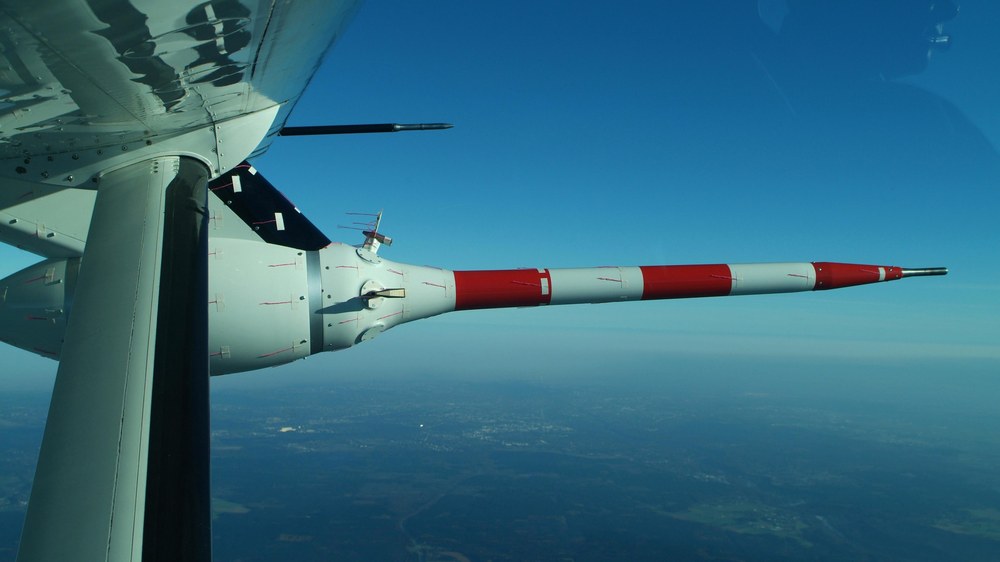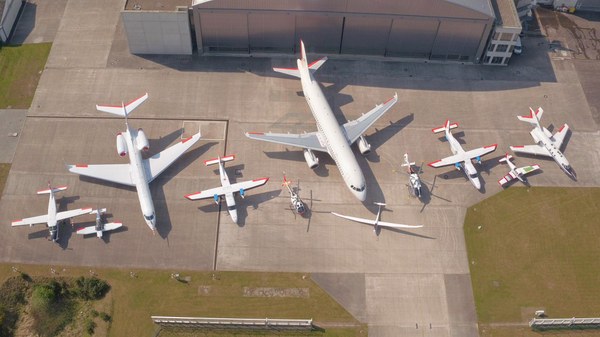DLR’s Flight Operations Facility is responsible for the deployment and utilisation of DLR’s fleet of highly-modified research aircraft.
Cessna 208B Grand Caravan: D-FDLR



The smallest aircraft of DLR's Oberpfaffenhofen flight facility is a Cessna 208B Grand Caravan, registration D-FDLR. The single-engine turboprop aircraft is mainly used by the German Aerospace Center (Deutsches Zentrum für Luft- und Raumfahrt; DLR) for remote sensing. It is especially well suited for camera flights, such as those with the HRSC (High Resolution Stereo Camera), operated by DLR and also used in space missions.
In 2006, the Cessna 208B was converted into a flying auditorium and equipped with an underwing meteorological measurement system capable of measuring turbulence. Since this conversion, the Cessna has seven individual measuring stations for aerospace students. The 'flying auditorium' project does not just enable students to experience different types of flight tests on board the aircraft; it also has a monitor with virtual cockpit instruments at each seat, allowing the students to track a wide variety of flight manoeuvres and measurement data in detail.
Like the Dassault Falcon 20E, the Cessna Grand Caravan plays an important role in the (EUropean Fleet for Airborne Research), an initiative bringing together 28 leading European institutions and companies in the field of airborne research.
The 'flying auditorium' system can be used to train:
- Aerospace engineers,
- Meteorologists,
- and aeronautical meteorological forecasters.
Modifications
Extensive modifications and extensions have turned the Cessna 208B into a popular research facility. With its lightweight but robust construction, it is well-suited for a wide variety of research uses involving smaller instrument sets.
The following modifications have been made to the Cessna 208B's aircraft structure and basic features:
- A meteorological sensor package developed for aeronautical use can be installed under the left wing when necessary. It measures temperature, pressure and humidity as well as wind speed and direction. The system is capable of turbulence measurements.
- Two small openings in the top of the Caravan's fuselage
- Two large covered openings in the bottom of the fuselage
- A specially modified exhaust system
- Additional generator for experiments (150 ampere and 50 ampere on two separate bus systems)
- Additional power supply connector in the floor for feeding experiments
- Underwing hardpoints for loads of up to 127 kilogrammes per wing
- High-precision navigation system (CCNS4 and AEROcontrol, both manufactured by IGI Gmbh, Germany)
Missions – research focus
Practical flight training with the 'flying auditorium'
The DLR flight facility in Oberpfaffenhofen offers opportunities for aerospace students and prospective atmospheric scientists to receive practical flight training on board the Cessna 208B. This concept, developed in cooperation with universities and colleges of higher education, allows the students to gain 'live' test flight experience.
The 'flying auditorium' replaces earlier forms of practical flight training for flight engineers. The new training concept is designed to provide students participating in the test flight scenarios with all the information on forces and movement data, which a test flight engineer needs in order to assess the flight performance of an aircraft. The Cessna 208B can accommodate a total of ten scientists and students. A measurement system comprising an inertial platform and two computers can store all available data and prepare them online for display. A so-called quicklook computer converts the raw data into physical data as they come in, and then generates a graphic representation. Each passenger has their own display in front of them, showing the current readings of the cockpit instruments. Other ways of representing the data, such as time series and real-time conversion of values (for instance to display airspeed as indicated, calibrated or equivalent), are also available. The manoeuvre for measuring climb performance, for example, can be traced in a graph of altitude over time. Time series can be useful to assess the quality of the manoeuvre. If there are too many disturbances, for instance due to turbulence, the manoeuvre may have to be performed again.
Test cards for several manoeuvres have been compiled in cooperation with universities. It is possible to draw up very detailed protocols for each stage and to record additional data (such as fuel consumption and the resulting change in the aircraft's mass during the flight) with these cards. Manoeuvres such as phugoid flight, the determination of the neutral point and manoeuvre point, the polar curve for gliding flight, or climbing power have all been prepared in this way. Additional weights can be used to vary the centre of gravity of the aircraft from flight to flight. In this way, a larger group of students, which has been divided over multiple flights, obtains a more extensive total pool of data, allowing them to analyse multiple distinct datasets.
The practical training sessions are organised and run by DLR flight facility Oberpfaffenhofen on behalf of universities.
Contacts | 'Flying auditorium' | Telephone numbers |
|---|---|---|
Christian Mallaum | Scientific supervision | +49 8153 28-3042 |
Stephan Storhas | Flight test engineer | +49 8153 28-1725 |
Oliver Paxa | Project management | +49 8153 28-1078 |
TropOLEX lidar system for two-dimensional measurement of ozone concentration
The 'TropOLEX' differential lidar system (Tropospheric Ozone Lidar Experiment; LIDAR: Light Detection And Ranging) developed by the German Aerospace Center, enables large-scale measuring of the vertical and horizontal ozone concentration from onboard the Cessna Grand Caravan. The compact system is based on the differential lidar technique (or DIAL for short). This means that two laser pulses with different wavelengths are emitted, and the backscatter signals of both waves are then compared. This method allows the concentration of atmospheric trace gases such as ozone to be measured
The vertical distribution of ozone in the troposphere is of interest to atmospheric researchers because ozone is one of the most chemically active substances in the atmosphere. It contributes to the greenhouse effect and to the development of photochemical smog, which are harmful to living creatures and plants. The airborne differential lidar technique has proven to be a useful tool for atmospheric research. Some airborne systems have, for instance, been used to study subjects such as air quality, air mass characterisation, biomass combustion and stratosphere-troposphere exchange.
Flying with the meteopod
When using a meteopod, a wider range of applications becomes available for practical flight training as well as for scientific missions. The meteopod is a container that can be mounted under the left wing and contains instruments for measuring meteorological parameters. This allows atmospheric parameters to be measured with less distortion than if they were measured from the fuselage. For example, students in Meteorology can under certain weather conditions - the meteopod can only be used in ice-free conditions - measure the vertical and spatial structure of the atmosphere.
Technical data
Cessna C 208B Grand Caravan | Data |
|---|---|
Length: | 12.7 metres |
Height: | 4.57 metres |
Wingspan: | 15.9 metres |
Cabin length: | 4.82 metres |
Cabin width: | 1.63 metres |
Cabin height: | 1.37 metres |
Seats: | 13 (for DLR research purposes: three crew members and up to three scientists or crew members, and seven students during practical flight training sessions) |
Empty mass: | 2.3 tonnes |
Total mass: | Maximum Take-Off Mass 3.96 tonnes |
Engine: | Pratt & Whitney Canada engine, PT6A-114 model with 675 shp |
Propeller: | three-blade, adjustable Hartzell propeller |
Range: | 1660 kilometres |
Flight altitude: | maximum 7.62 kilometres (25 000 feet) |
Speed: | maximum 314 kilometres per hour (10 000 feet) |
Endurance: | 5 hours and 30 min Stunden (without payload) |
Fuel tank capacity: | 1 tonne |
Original use: | passenger, rescue, supply and cargo aircraft |
DLR flight facility: | Oberpfaffenhofen |

